A few weeks ago I visited Costa Rica for the second time in hopes of a journey to discover traditional Costa Rican food.
To be fair, the first time I visited Costa Rica I was traveling from Nicaragua through to Panama.
I basically spent two days in Alajuela, a suburb outside San Jose. And I remember thinking the gallo pinto was different than Nicaragua but that was about it.
I loved that Nicaragua was underdeveloped in tourism as many people were still afraid to visit it in 2010 and adored Nicaraguan food.
So moving onto Costa Rica wasn’t as interesting for me.
It had already become a popular eco-adventure spot and I thought it was going to be just a bunch of ziplining and sloths.
‘
I decided to give Costa Rica a second chance by traveling with my friend Rease.
I met her in Buenos Aires in 2011, when for some odd reason she didn’t eat meat.
I was excited to go to Nicaragua with her but after four days we had to leave for safety reasons – which I have never written about because I was so sad but her post really captures what it was like to be in Nicaragua during civil unrest.
She had visited northern Costa Rica and had done the typical eco-adventure rainforest thing.
We wanted to see what was beyond the typical tourism so we chose to visit southern Costa Rica.
Of course I had started a list of Costa Rican food, cocktails and where to eat, Rease looked into what we should do between meals.

I researched typical food in Costa Rica in hopes we would be able to find everything.
We did not.
We chose to go to Puerto Viejo and the first day I noticed something odd. There was a lot of vegan gluten-free cafes.
So we went to a soda which is a restaurant that serves traditional food.
But even though it was across the street from the beach, the fish was frozen.
Whyyyyyy??????
I left feeling defeated. Costa Rica is a beautiful tropical country.
But I do not recommend Puerto Viejo’s surfing/hippie/yoga/gluten-free/vegan culture as the best place to find traditional Costa Rican food.
That said my highlight was when I took this cooking class in Puerto Viejo with Elena.
She was really frank about the problem with gringo food replacing traditional food in town and did offer a few spots to eat.
Also, her food was some of the best we had.
I did have some great food.
It was just hard to find amongst the tacos, dollar shots and fusion spots.
I chose the wrong town, I should have looked into Puerto Viejo more carefully.
On my Uber ride in San Jose to the airport I had a great chat with my driver who understood my frustration.
He said much of Costa Rica had been gringo-fied and if I really wanted great typical food in Costa Rica I should go to Guanacaste.
Costa Rican Fruit
So I wasn’t able to eat all 30 Costa Rican foods on this trip but I did want to publish this list.
Some of the food I’ve had in other Central American countries like Nicaragua and Panama.
And much of Costa Rican food is similar to Jamaican food because Jamaican immigrants came here to work on the Costa Rican railroad.
And maybe I will give Costa Rica a third shot?
‘
Influences On Costa Rican Food
There are several different influences that are reflected in the food that you will find in Costa Rica.
Naturally, the influence of the indigenous population plays a significant role in many of the dishes, with corn playing an important role in these dishes.
And as with most of Central America, the Spanish conquistadors also had a significant influence, with both ingredients and Spanish cooking techniques seen in many dishes.
Particularly on the Caribbean coast of Costa Rica, you will also find a strong Afro-Caribbean influence.
Dishes are often flavoured with coconut, while plantains and seafood are common ingredients.
I noticed MANY of the foods I tried here were also in Jamaica. In fact many of the exotic fruit trees in Costa Rica were also planted by Jamaican immigrants.
Sometimes if you want the flavour of home you have to plant it yourself.

Traditional Costa Rican Food
Gallo Pinto
Gallo Pinto is the national dish of Costa Rica and neighbouring country Nicaragua.
This dish is also one of its simplest, made with a combination of rice and black beans.
The black beans are slow cooked in water for several hours before they are required to soften them.
Caribbean Rice and Beans
The beans are then combined with the rice, peppers, onions and garlic to be sautéed, before then cooking it in the water used to prepare the beans.
This ends up giving the rice quite a dark colour, which is speckled with the black beans and peppers that stand out.
Gallo pinto is served most often for breakfast, but can also be a side for lunch and dinner as well.
The name of the dish translates as ‘spotted rooster’, which is a reflection of the spotted appearance of the dish.
The cooking techniques of the dish have an African influence, while the beans are an ingredient that has been used by the indigenous people for centuries.
In southern Costa Rica, in towns like Puerto Viejo gallo pinto is often replaced by a similar dish called rice and beans.
It often uses red beans, coconut milk and a spicy Panamanian pepper.
Rice and beans are WAYYYYY better than gallo pinto. The addition of coconut and spiciness makes rice so delicious.
I would definitely make this at home and now I have the recipe for beans and rice after making it at Elena’s cooking class.
Arroz con Pollo
Another simple dish that has rice at the heart of it, arroz con pollo is simply chicken and rice.
It’s a popular Honduran food; however, the ingredients can vary significantly regionally.
The rice is often cooked with onions, celery, sweetcorn and peppers, and can include other vegetables as well.
The chicken is usually cooked separately, and added in to the rice towards the end of preparation.
The rice and other ingredients are usually cooked in chicken stock.
Many recipes also add salsa lizano or soy sauce. It’s also drizzled in lime juice, and can be served with salad and potato chips or fries.
I rarely order chicken but I did have this during my overnight stay at the Yorkin Bri Bri community tour and not only did I love the tour but the chicken was delicious.
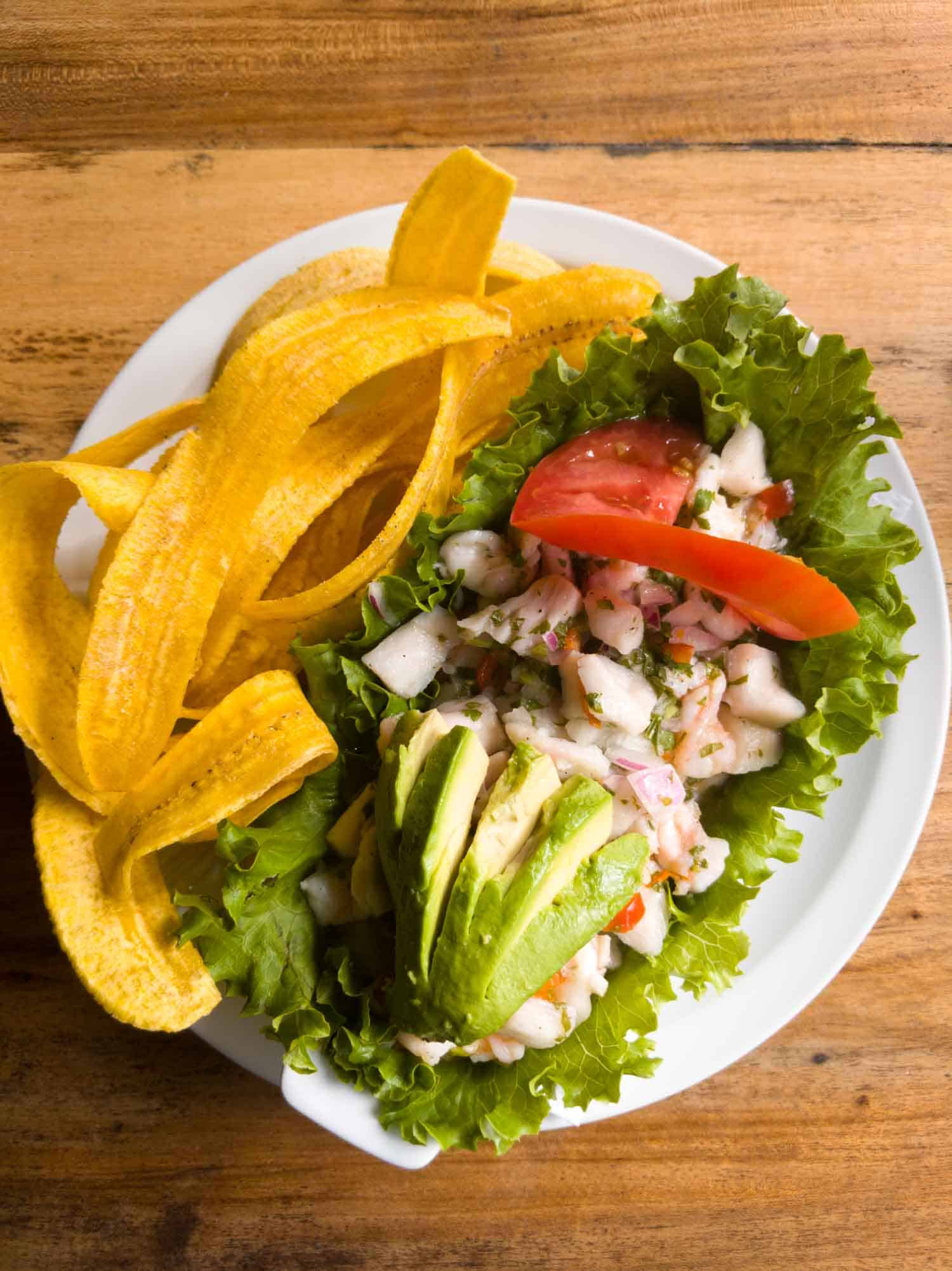
Ceviche
There are variations of ceviche found across South and Central America. Around the world there’s also Hawaiian style poke and Filipino kinilaw.
And here in Costa Rica there are plenty of ceviche varieties.
You will find ceviche often prepared with sea bass, snapper or abalone, while there are also shrimp and octopus versions too.
Peruvian Ceviche
The fish is diced before being soaked in a combination of lemon and lime juice, chopped onion and peppers.
Some varieties will also include chili powder or Panamanian peppers. In northern towns it’s not as spicy as not all Costa Ricans like spice.
One of the secrets here is that the citrus juice is often supplemented with ginger ale which gives it an interesting kick.
I had this ceviche at Hotel Banana Azul, which did have lots of traditional food options and an amazing tipical Tican breakfast included with the room.
They hosted me for two nights but I thought the room rates were very reasonable for the quality of hotel.
You can check out reviews on TripAdvisor or check rates on Expedia. I highly recommend and would absolutely pay to stay here myself.
‘
Chifrijo
This isn’t a traditional Costa Rican food. It was invented in the 90s and is a great bar snack.
However, it does use typical ingredients from Costa Rica as rice and beans is its base.
But what makes it tasty is the inclusion of chicharrones, or the fried pork rinds that are often served at bars.
The crispy fat gives the dish a great meaty flavour and a change in the texture as well.
The rice and beans are cooked in stock with a variety of vegetables, before the chicharrones are added.
The dish is usually served with tortilla chips and topped with salsa. I had this at the airport in San Jose, it is pretty good with an Imperial beer.
Chorreadas
This is one of the most common breakfast dishes in Costa Rica, and is a type of pancake. Normally chorreadas dough is traditionally only made with corn.
However, it is now more common to find the dough bound together with eggs and a little flour.
The dough is then quickly fried to make for a tasty moist pancake.
Although these can be served as either sweet or savoury, chorreadas are most commonly served with a dollop of sour cream.
‘
Casado
Casado isn’t so much one thing but a type of meal. It literally translates to “married.”
And when you order a plate of lunch there will be individual options for sides or you can ask for casado which means a bit of everything.
Casado is often a handful of salad, rice, beans and often plantains.
It is filling and was initially popular with labourers but now it’s a great way to try a bit of everything.
I also like to eat this way so I don’t have to be disappointed that one of my side dishes isn’t very good.
Sopa de Mariscos
There are relatively few soup dishes in Costa Rican cuisine, when you compare this with other areas of Central and South America.
This is a seafood soup that can be prepared with whatever was available at the fish market in the morning.
Brazilian Shrimp Soup
It has a tomato base. Common seafood included can be snapper or sea bass, while it will also include shrimp and shellfish such as clams and mussels.
‘Tamales
Tamales are found through Latin America and are a common Honduran food. Tamales are prepared using the corn that is grown across the region.
Traditionally, the corn is cooked the previous day to soften it before it is then made into a dough that is used for the tamale.
There are some varieties of tamale in Costa Rica where the dough is simply seasoned before cooking, but in most cases it is stuffed with meat and onions.
The tamales are then wrapped in banana leaves ready for cooking. The tamales are then steamed inside the banana leaves before being served.
Arreglado
An interesting variety on the sandwich, arreglado is made with a type of puff pastry dough rather than bread to contain the ingredients.
Most versions will have some form of meat such as cooked steak or pork as a filling.
Meat and vegetables such as tomato and lettuce make the filling, before being topped with a generous serving of cheese.
These little sandwiches are a tasty snack or can be accompanied with French fries or potato chips.
The name of the sandwich translates as ‘arrange’, which refers to the clear layers that are visibly arranged in the sandwich.
‘Pati
This dish is particularly found on the Caribbean coast of Costa Rica, and has a strong African influence.
A pati is essentially a pastry turnover that is then stuffed with a tasty filling. You may recognize it as being the cousin to the Jamaican patty.
This filling is commonly made of ground beef that is supplemented with spices and hot peppers, along with being fleshed out by a little onion.
Traditional Jamaican Foods
Pati is a dish that is often served in many of the celebrations and family events of the local people.
The Caribbean influence is clear as this tasty pasty has more of a kick than much of the traditional Costa Rican cuisine.
‘Salsa Lizano
Although this is not strictly speaking a dish, Salsa Lizano is a brand of sauce that has adorned tables in Costa Rica for close to a century.
Often used as an ingredient in rice dishes, or as an accompaniment for gallo pinto, this sauce is almost the flavour of Costa Rica.
The sauce was launched in 1920, and is quite a thin sauce that has a sweet and tangy flavour.
It’s somewhere in between Worcestershire sauce and perhaps A1 sauce. It has the umami flavour in a way you’ve never had before.
‘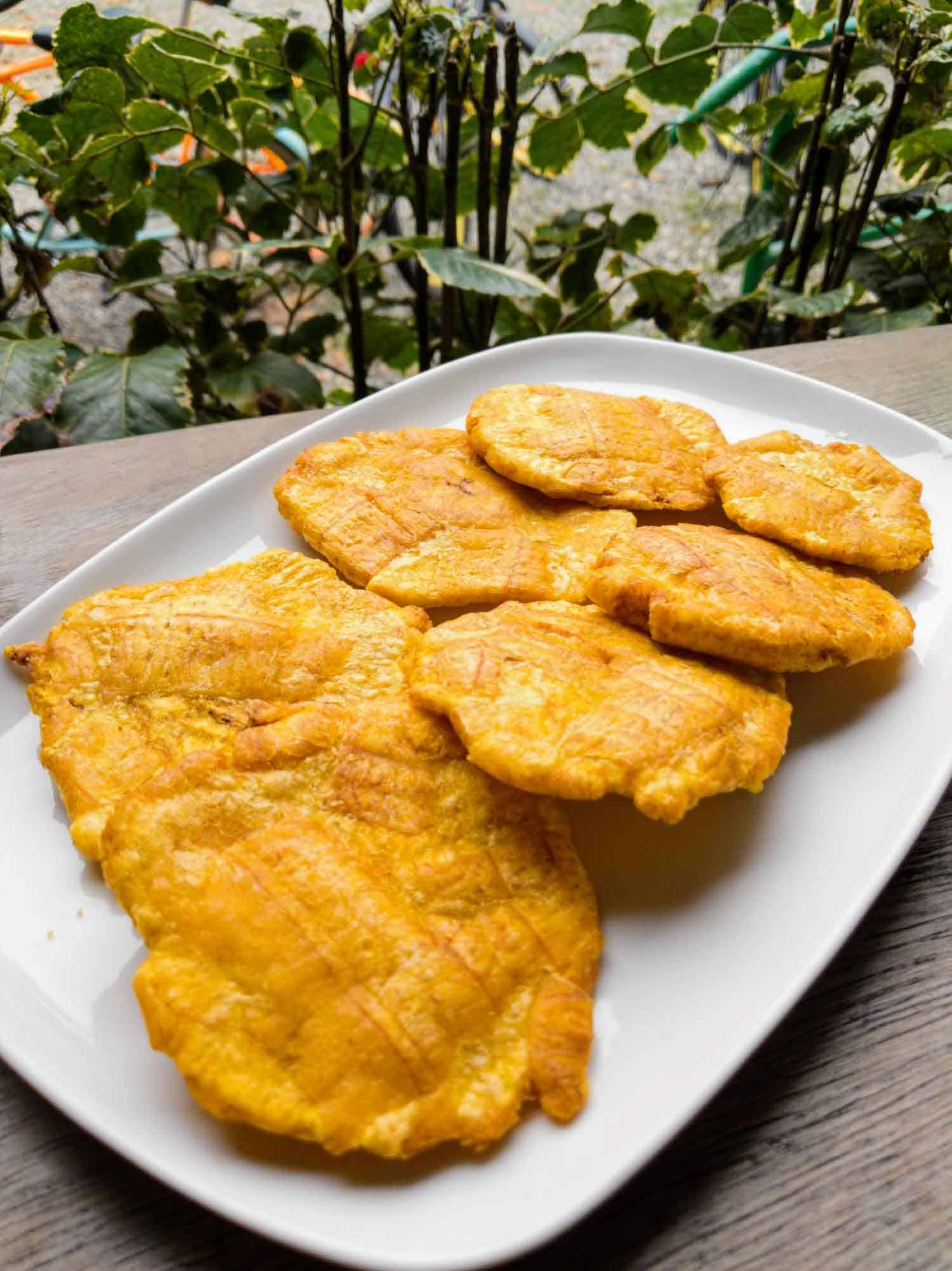
Patacones
Patacones are found across Mexico and Central America and sometimes called tostones.
However, I have never seen them so often as I did in Costa Rica.
I ate them every single day.
Plantains are also known as green bananas. They look like bananas but are not sweet and quite starchy.
Green plantains are cut into chunks, boiled until soft then flattered into pancakes and fried.
The key to cooking great patacones is that they need to be fried twice.
The slices of plantain are then sprinkled with salt to flavour. In Cuba it’s also common to have them with garlic – which is really the best way.
They are often served as a side dish with gallo pinto or other main meals, while they can also be served with salsa or other sauces as a snack.
Olla de Carne
Much like soups, stews do not generally play a large role in Costa Rican cuisine. However, in this case it is worth seeking out olla de carne.
As the name suggests, this is a meat stew that is prepared with beef for a rich flavour.
The beef is slow cooked in a broth with a range of vegetables, including cassava, carrots, corn and taro root.
Sweet potatoes and plantains are also often added to the stew for variety. With slow cooking, the meaty flavour generally permeates the whole dish.
The stew is served both in homes across the country and in restaurants. It is most commonly served over rice, which helps to absorb the broth.
‘
Rondon
This was the #1 thing I wanted to eat in Costa Rica. I first heard about it in Nicaragua, where it also exists on the coast but I wasn’t able to try it.
But I am happy I had to wait because in Nicaragua it is a bit different.
It was absolutely my favourite dish and I’m going to make it at home. The name is a Spanish-ified version of the English name in the Caribbean – “run down.”
This is meant to reflect that it’s a versatile dish that has a base flavour and can hold any kind of fish or whatever you can run down.
I would best describe it as a Caribbean seafood chowder. But it different from a traditional Canadian chowder with the addition of coconut milk and Panamanian pepper.
Commonly the protein in the dish is fresh fish, lobster or crab. The vegetables for the dish include cassava, taro root and plantains, which are cooked as large chunks, before being served.
It is hearty, coconuty and spicy. Everything I love to eat.
If you can only eat one Costa Rican dish this would be it.
Sopa Negra
Along with Sopa de Mariscos, this is one of the other soups that you are likely to encounter during a trip to Costa Rica.
As black beans are such a key part of the diet here, this is quite simply a black bean soup.
The beans are prepared with a broth seasoned with cilantro, black pepper and garlic, and also including an onion and a red pepper.
This is cooked over some time to soften the beans, while eggs are then added to the boiling broth for the last few minutes.
These are then shelled and added to the soup for serving. The soup is often served with a tortilla and a portion of rice.
. ‘Arroz con Mariscos
Rice is one of those ingredients that is found in almost every cupboard in Costa Rica, and often on almost every plate.
In this dish the rice is fried with a variety of seafood, and this can include shrimp, shellfish and whatever fish is available at the time.
This mix of rice and seafood is then supplemented with vegetables such as peas, chopped celery and peppers.
This helps to add to the colour, but the real dash of colour comes from adding achiote, which gives the rice a golden yellow hue.
‘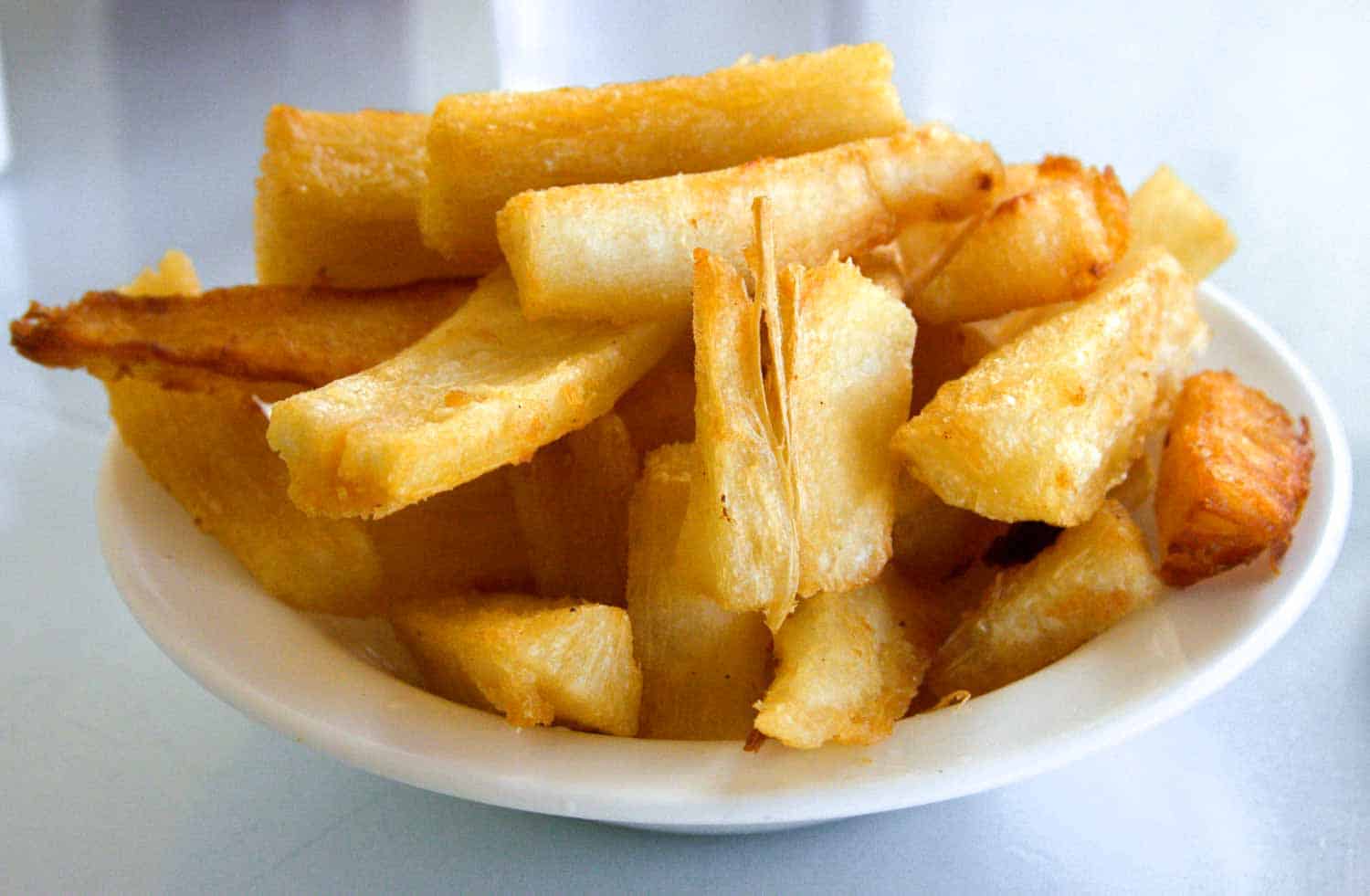
Yuca Frita
I love all the root vegetables in the Caribbean. This is a side dish that can accompany a range of different dishes in Costa Rica.
Yuca is also known as cassava. It is is a starchy vegetable that is very hard tuber.
It is really hard so it is first boiled to help soften the flesh of the vegetable then sliced lengthways into chunky fingers of yuca.
Not surprisingly, these are also a common food in Panama, where yuca grow easily.
Boiled yucca sticks are then deep fried to give them a great crunchy exterior and a softer flesh inside.
Yuca frita can be served as a side dish, while some people may also eat it as a snack served with salsa or a sauce for dipping.
Picadillo
Picadillo is one of those dishes that are designed to use leftovers. It’s very similar to picadillo in Cuban cuisine, although there are far more ingredients available in Costa Rica.
Often made using potatoes, picadillo can be made with chayote, green beans and almost any other vegetable.
These vegetables are chopped into small chunks, cooked with bacon, ground beef and a variety of other vegetables.
The mix is then seasoned with achiote and cilantro before being cooked.
Picadillo is often served as a side dish for many meals, while it is also often served with eggs for breakfast.
‘Sopa de Pejibaye
The pejibaye is a unique Costa Rican fruit that grows on palm trees.
Here, these fruits are slow cooked to soften the flesh, before being blended with milk, chicken stock and onions to make a soup.
Also called crema de pejibaye, the milk helps to make this quite a creamy soup, while it also has a hint of sweetness from the fruit.
‘Street Food In Costa Rica
Costa Rica does not share the wealth of other countries in terms of the variety of the street food available.
Equally, Costa Rican street food is not quite as distinctive as found in some other countries like Mexico.
However, you will often find plenty of stalls and hole in the wall cafes as you explore, which can be well worth trying.
Here are a few common dishes you are likely to find:
Pinchos
For anyone who has visited Spain, they will think of pinchos as a type of small snack that are speared by a cocktail stick.
Here in Costa Rica pinchos do still have a sharp stick. However, it is used to skewer chunks of meat to be barbecued instead.
Pinchos may occasionally have a chunk of bread or plantain at the end of the skewer, but this is generally just meat.
Chicken and pork are the most common options, but other meats may also be grilled.
These meats are marinated in oil, annatto seasoning and a local barbecue sauce. These are then cooked on the barbecue and served hot and ready to eat.
Pupusa
One of my absolute favourite snacks in Central America.
Originally found in El Salvador, pupusas are also one of the most common treats enjoyed across Costa Rica.
The pupusa is a very simple dish that is made of a cornmeal dough, which is then stuffed before cooking.
These look like a thick pancake or stuffed arepa. However, the thin layer of stuffing offers a tasty and hot snack on the go.
Common fillings for the pupusas include a mix of black beans and beans.
You will also find fillings that include beef, chicken or pork rinds that have been prepared with a sauce before cooking.
I’ve never been to El Salvador but if the rest of the food is as good as pupusas then I need to make this my next trip.
‘Empanadas
Empanadas are one of the staple street foods across South and Central America.
Each country tends to have a slight variation on the theme, and Costa Rica is no different.
This pastry turnover uses a cornmeal dough. It is flattened into a pancake shape then filled and folded.
Not the healthiest snack, it is deep fried before being served, preferably fresh and hot!
Ecuadorian Cheese Empanadas
There are many different types of empanada filling you will encounter, but one typically Costa Rican option is black beans, chorizo and cheese.
You will also find varieties that have a beef, pork or chicken filling, while other more adventurous varieties are also available.
‘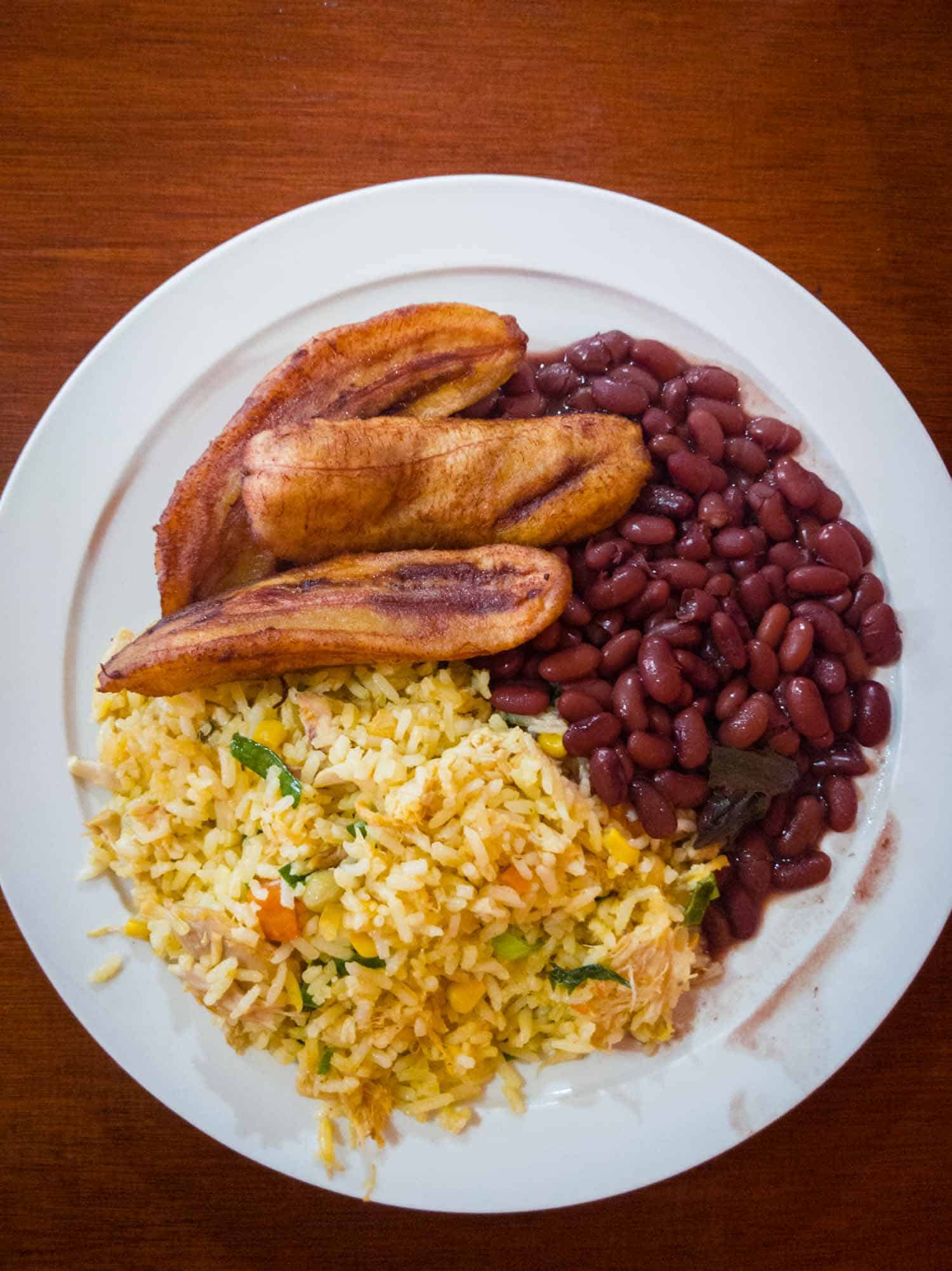
Arroz Cantones
Chinese food is very common across Latin America.
The Chinese brought rice to Peru and it was immediately loved so much that chifa is a form of Chinese Peruvian food beloved in the country.
Costa Rica has also embraced a Chinese influence in its food with cantonese rice. This is a dish of Chinese style fried rice that takes one of Costa Rica’s main crops.
Like several of the rice dishes in Costa Rica, here the rice is supplemented by peppers, celery and onions.
There is also usually a variety of meat and fish, which can include chicken, pork, ham and shrimps.
The key ingredient in the preparation is soy sauce, which gives the rice a darker, richer colour.
There are often stalls selling arroz cantones in the evenings, while you will also find stalls and trucks offering this tasty dish at festivals and events.
. ‘Queso Palmito
Cheese is often very different in South and Central America to the rest of the world.
Soft white cheeses are the most common here, and queso palmito is a particular type of cheese that is easy to eat on the go.
The cheese is usually wrapped in a large leaf and some string to hold it together.
This cheese has a light and salty flavour. It pulls away from the heart of the cheese as string cheese does.
This makes it a tasty cheese to eat on the go, and is often sold at roadside stands for travellers.
‘Costa Rican Desserts
Tres Leches Cake
Perhaps the most popular dessert in Latin America. You can find versions of tres leches cake throughout Central and South America and is one of the most popular Peruvian desserts.
Essentially, this is a sponge cake that is soaked in milk, condensed milk and evaporated milk.
This helps to give the cake a wonderful moist texture, and a great creamy taste.
Presentation can vary, so they may be prepared as individual cake portions, or as a slice of cake taken from a larger round sponge.
The cakes are usually covered in a light whipped cream and decorative toppings like a maraschino cherry.
Granizados
In a country that has a hot climate such as Costa Rica, it is no surprise to find ice desserts are very popular. Basically slushies, granizados are served in plastic cups by street vendors.
Granizados are served in tall glasses as a dessert in a restaurant.
Shaved ice is combined with condensed milk and powdered milk, which is then smothered in a sweet syrup.
Common flavours include coconut, mango and grape, while more adventurous options such as blue raspberry are also available.
It’s one of the most popular drinks in Colombia, but called a cholado and it’s called raspao in Panama.
Torta Chilena
As the name for this dish suggests, it is believed the origins of this cake actually come from Chile.
Essentially, this is a cake made of several layers of pastry that provide the sandwich for several layers of dulce de leche.
Dulce de leche is most commonly associated with Argentinean desserts. It’s a wonderfully thick and sweet confection that is made with condensed milk.
The layers are then put together into one pastry cake, which is then liberally covered in a layer of icing sugar to finish.
‘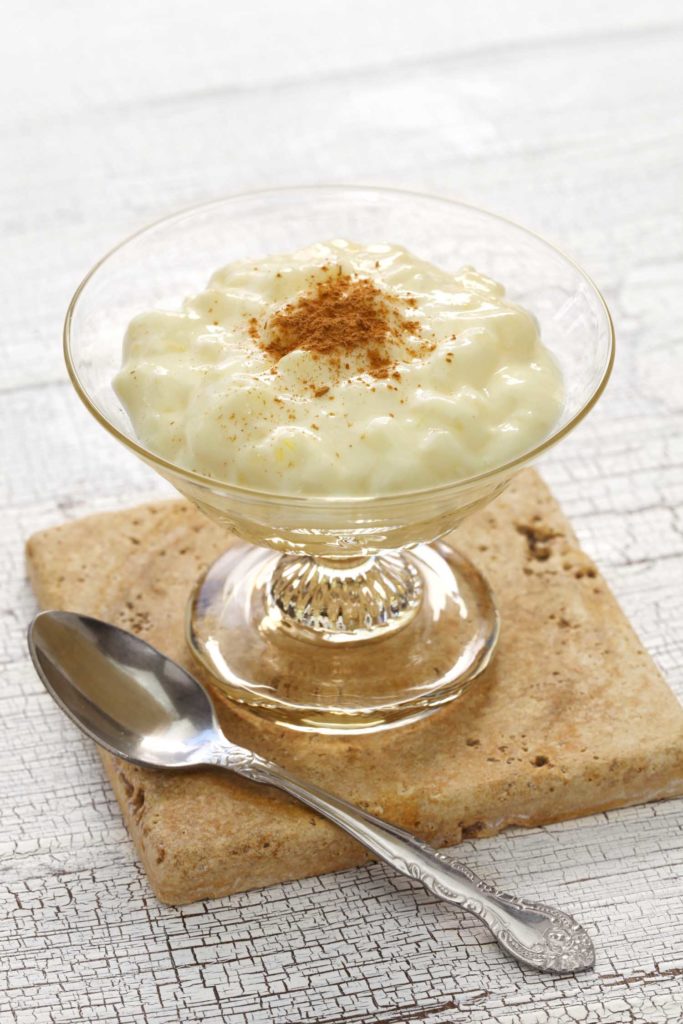
Arroz con Leche
This Costa Rican rice pudding brings together two of the main products found in Costa Rican cuisine.
Combining dairy and rice, this dish is generally made with long grain rice that is cooked in milk, condensed milk and evaporated milk.
Raisins, vanilla and nutmeg are also common.
However, it is the cinnamon that gives the rice pudding a wonderful flavour that is popular across the country.
‘Churros
You can guarantee that if you are in a country that speaks Spanish, it will have churros.
Originally from Spain, it is one of the few Spanish dishes that is found in every Latin American country.
The churro is effectively a tube of light dough that has been fried. It is usually dusted in sugar to serve.
Cinco de Mayo Desserts
While some churros can be made entirely of dough, others are stuffed with dulce de leche or a sweet chocolate cream before cooking.
Sometimes enjoyed with a morning coffee, or as a decadent dessert, churros are one of the most popular foods in the country.
Cono Capuchino
As you would expect in a country that has the climate of Costa Rica, cold desserts are very popular.
The cono capuchino is a thick waffle style cone which is used to hold the fillings.
This is then filled with ice cream, which can be scoops of ice cream or also a soft serve style whipped ice cream.
In Puerto Viejo it can get quite elaborate, begging for an instagram photo.
This cone is then dipped into a thick chocolate sauce which finishes the dessert.
It is ideal as a snack on a hot day. You can find it at street vendors or also served in restaurants and cafes as well.
‘Did I miss any of your favourite Costa Rican food, please let me know in the comments below!
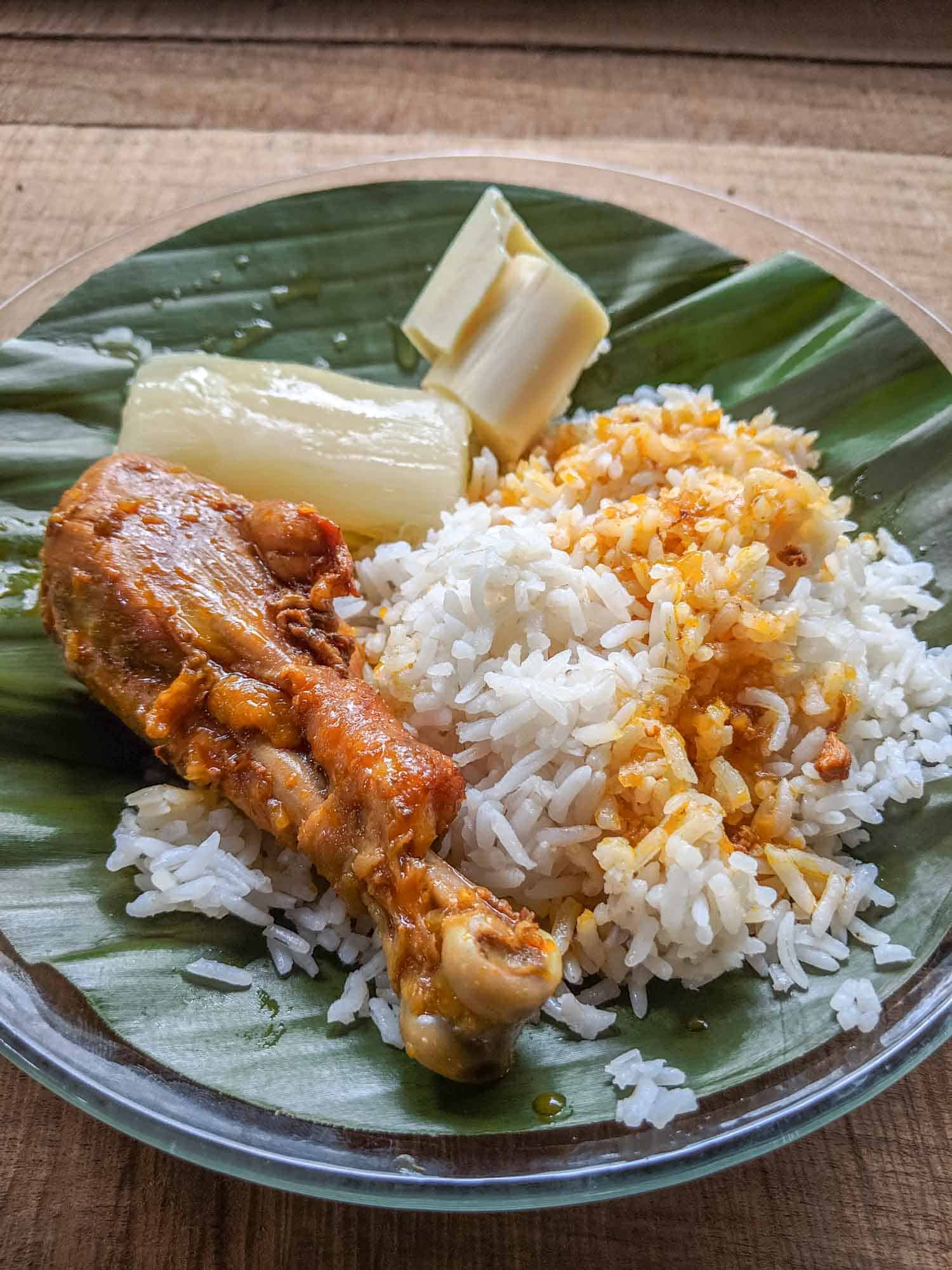
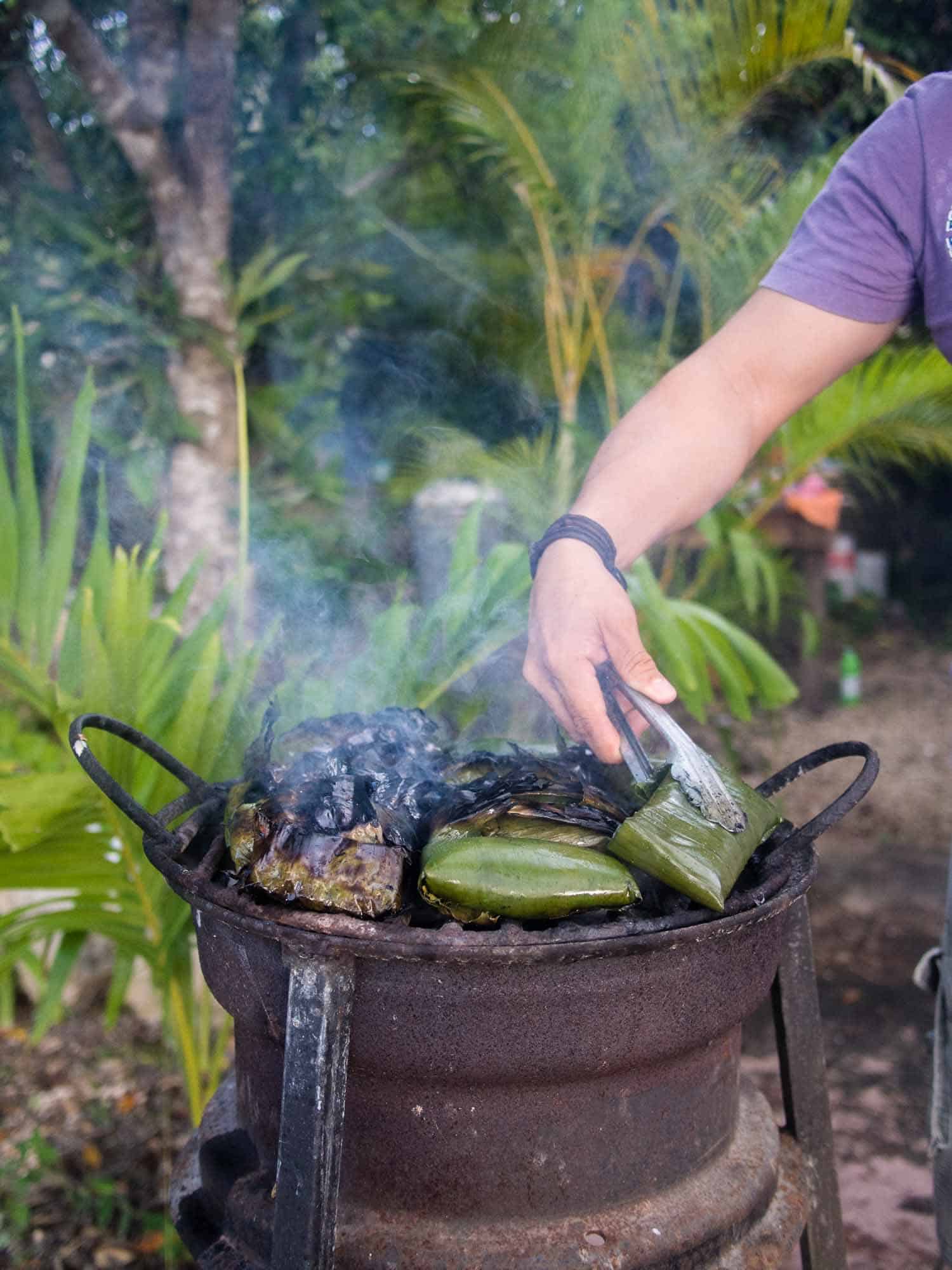


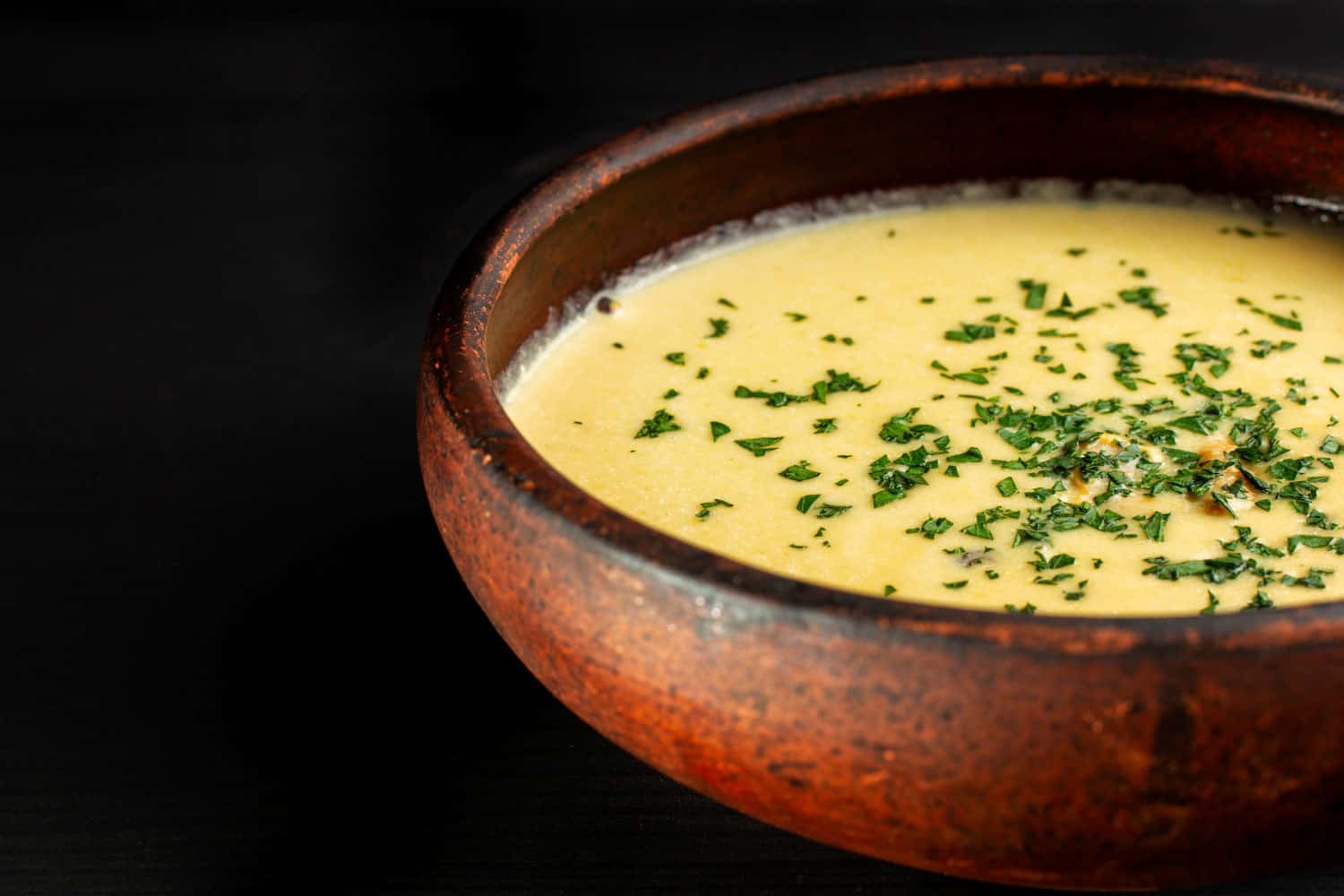
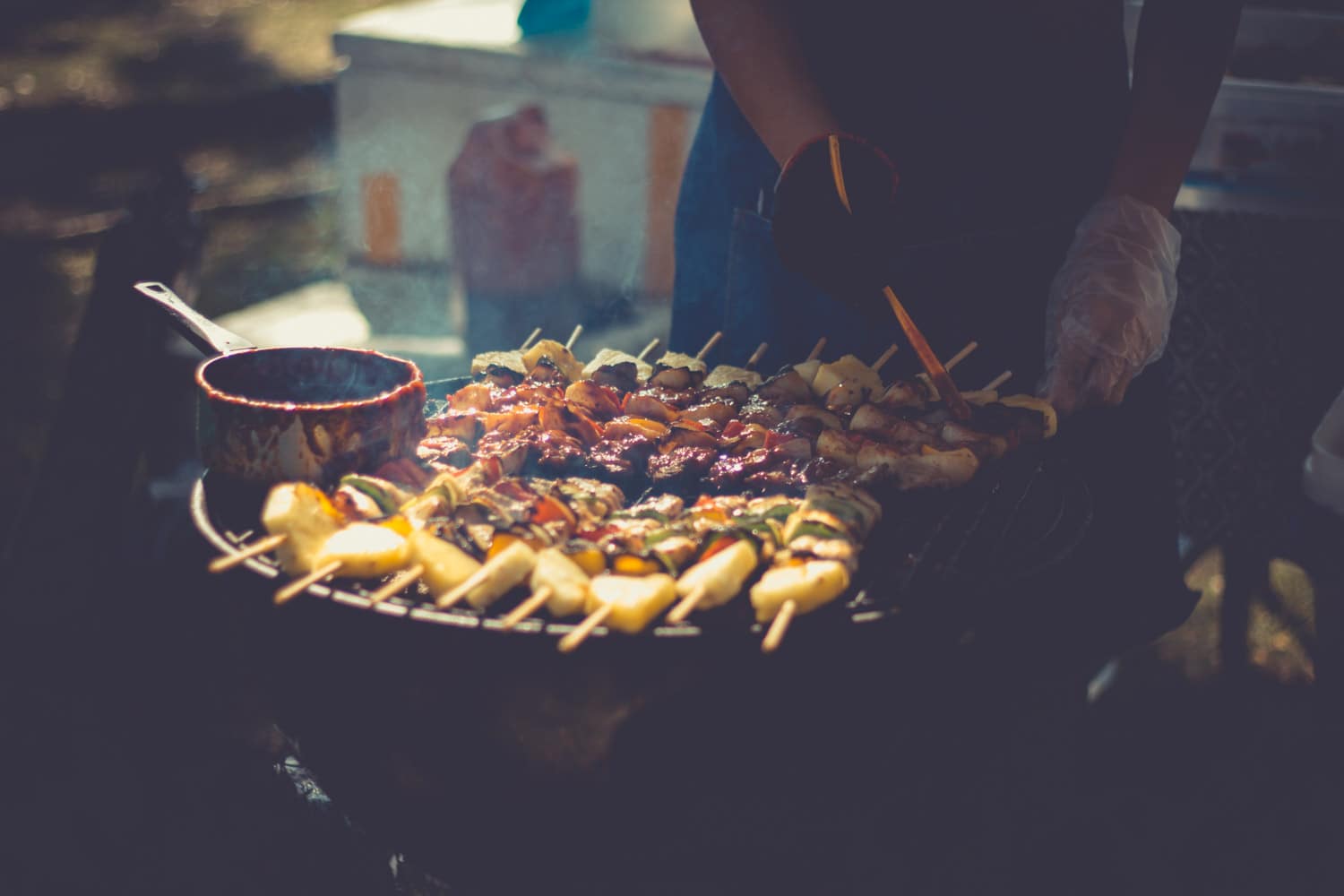
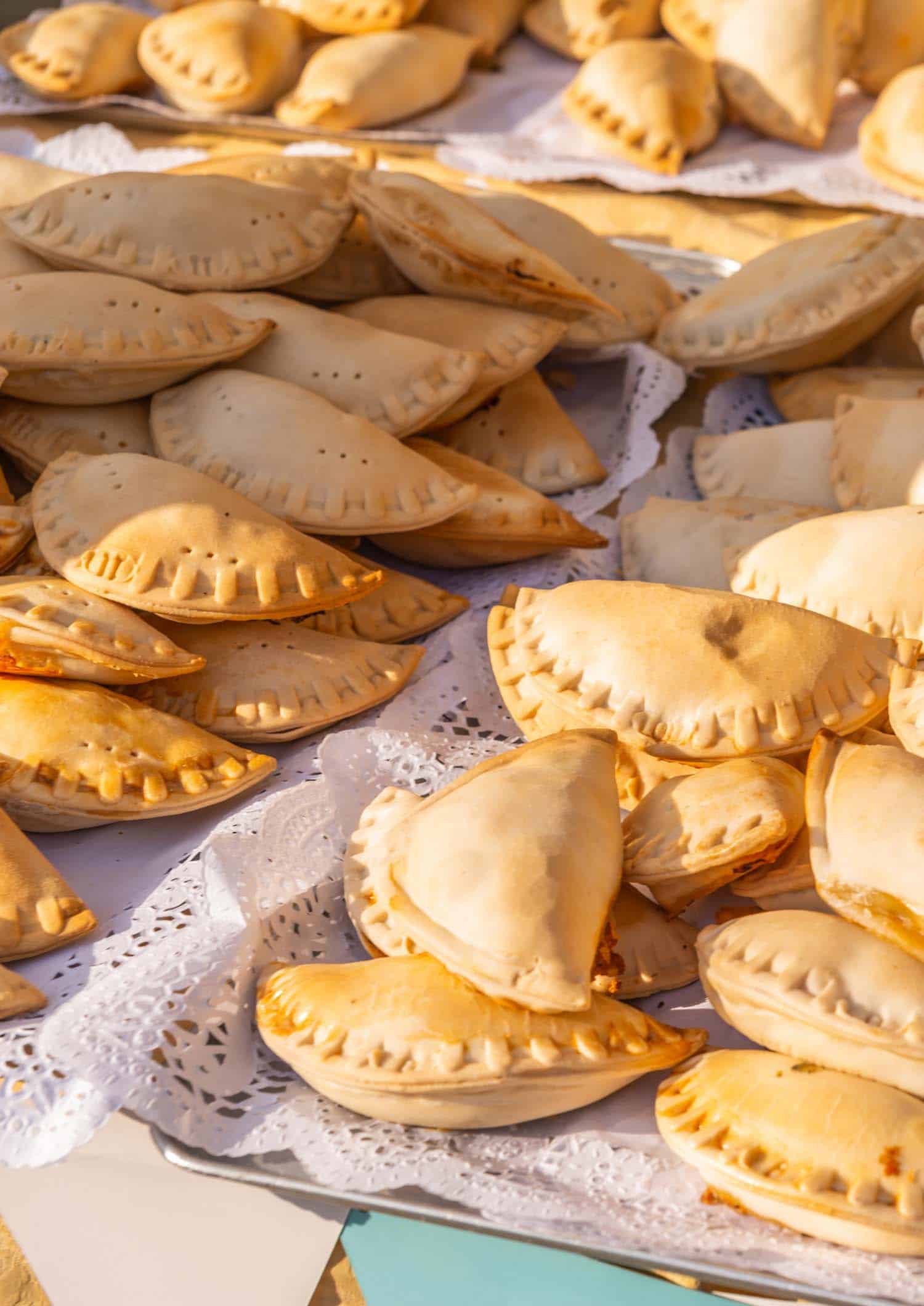

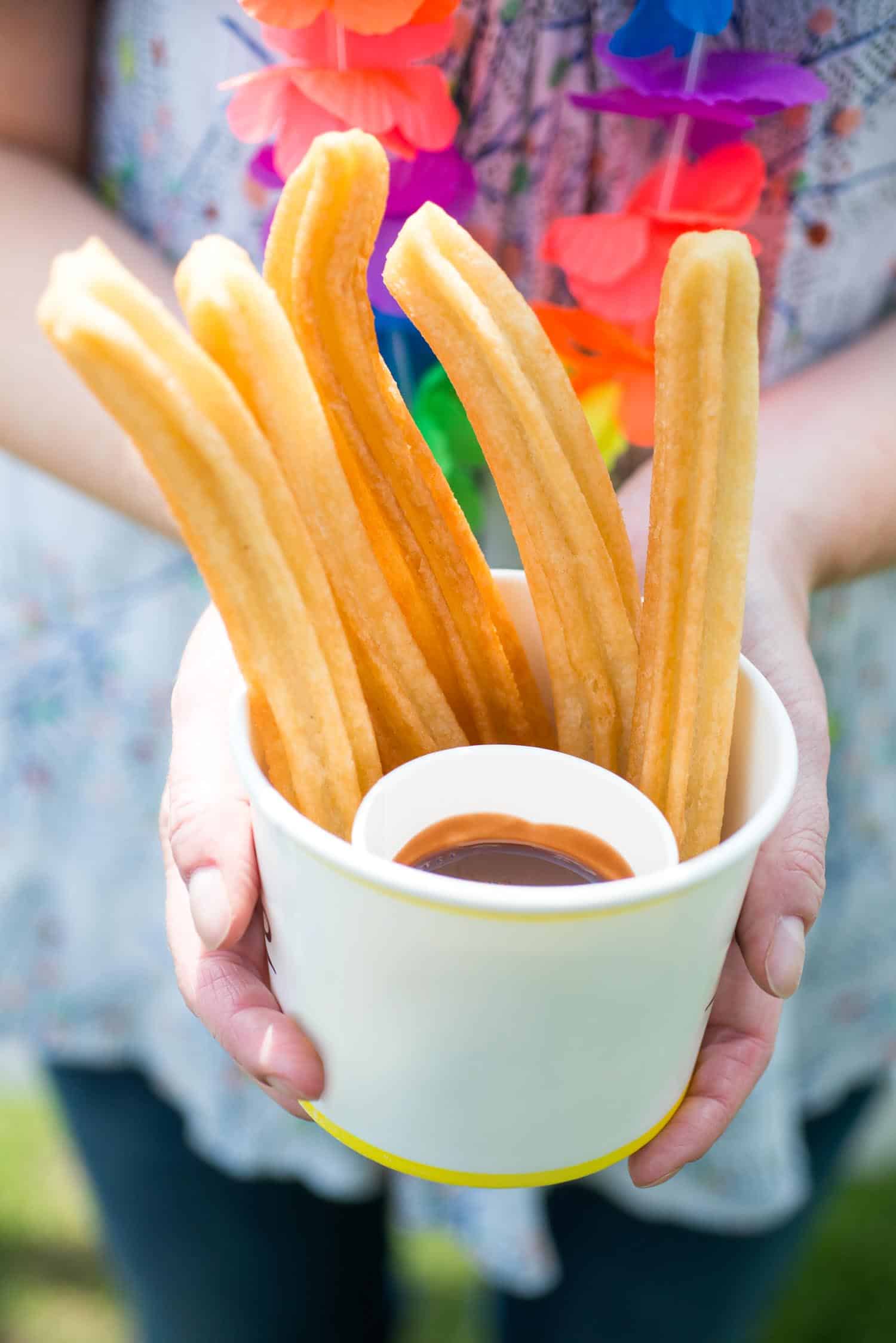
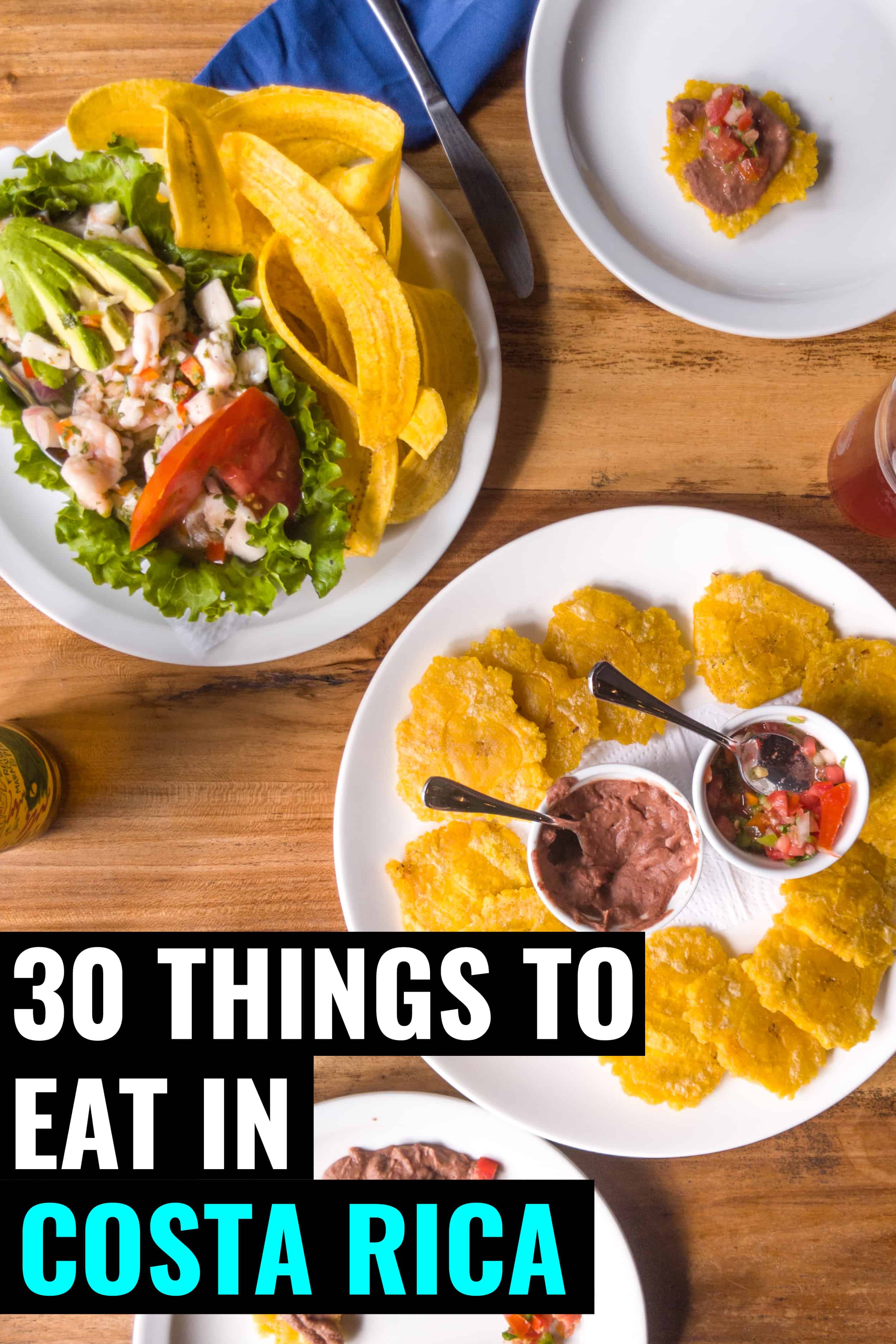
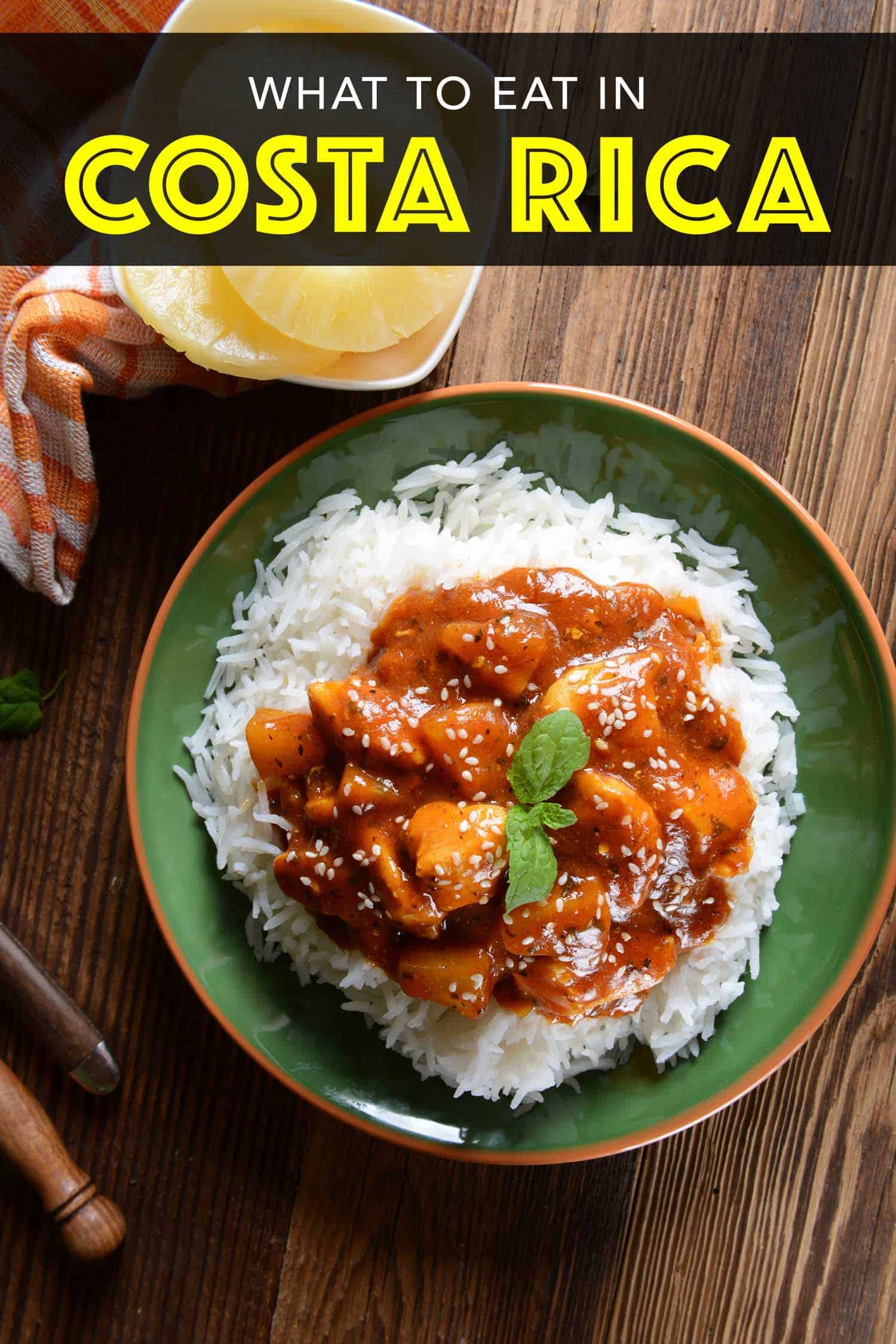
Thank you so much! Your article was so helpful! We are staying at the Banana Azul on October & so excited.